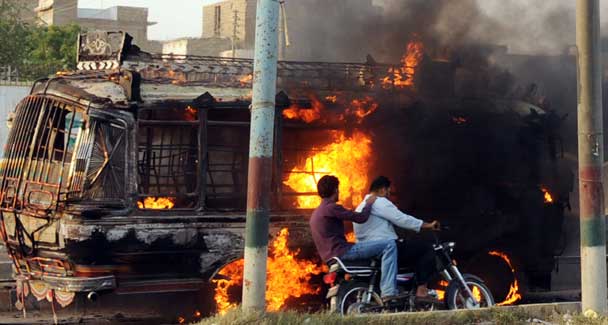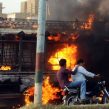
Karachi’s Deadly Political and Sectarian Warfare Threatens the Stability of Pakistan’s Commercial Capital
Publication: Terrorism Monitor Volume: 10 Issue: 8
By:

Karachi is one of the most violent cities in the world where, according to Additional Inspector General of Police (AIGP) Akhtar Hassan Gorchani at least 396 persons have lost their lives in ethnic, sectarian, and political violence in the first three months of 2012. [1] Forty-seven of these murders were targeted killings while 24 of them were political and ethnic killings. However, the violence in Karachi cannot be explained by mere statistics. Dozens of state and non-state actors are involved in this violence for as many reasons.
Political violence was introduced to Karachi in the mid-1980s by the Muhajir Qaumi Movement (MQM), which emerged as the ethnic party of the muhajir, refugees from the Muslim-majority areas of the British India in 1947. Renamed in the late 1990s as the Muttahidda Qaumi Movement (MQM – United National Movement), it largely remains a party of the muhajir and their descendants. In the late 1980s and 1990s, the bodies of MQM opponents were frequently found in gunny bags on Karachi’s roadsides and many of the MQM’s political rivals blamed these killings on the movement. [2] Several law-enforcement operations also unearthed torture cells run by the MQM. [3] Under pressure from the Pakistani military, a small group led by Afaq Ahmed split from the MQM in the late 1990s under the name MQM-Haqaqi. Since then, the two factions of the MQM have been at each other’s throats. The military operations and the split of the MQM-Haqiqi weakened the mainstream MQM; but not enough to stop it from using violence as an instrument of its political strategy.
Demographic change in Karachi in the 2000s further weakened the MQM. Large numbers of Pashtun tribesmen migrated to Karachi as a result of the Taliban’s rise and the initiation of subsequent military operations in Pakistan’s Khyber-Pukhtoonkhwa Province. As a result, the Pashtun-based Awami National Party (ANP) succeeded in having two lawmakers elected from Karachi. As the ANP encroached on turf which the MQM claimed as its exclusive right, political violence spread, pitting the MQM against the MQM (Haqiqi) and the ANP. [4] Although the ANP is a peaceful political party, some of its members have met the MQM’s violence with violence, but on a much smaller scale. [5]
Any murder of a political worker causes large outbursts of violence. When an MQM worker and his brother were assassinated on March 27, the entire city was shut down. Eleven people died in the ensuing violence while angry mobs set some 45 vehicles alight. The killing of an ANP worker the next day sparked another wave of violence that left 14 persons dead and 53 vehicles set on fire. [6] Interestingly, both parties are coalition partners of the Pakistan People’s Party (PPP) in the central and provincial governments. The PPP governments are thus unable to take action as they cannot afford to lose their coalition partners.
As Karachi is the commercial center of Pakistan and until recently the only port city, jihadi groups, particularly those of the Deobandi, have long focused on the city for fundraising. The rise of jihadi groups in Karachi greatly agitated the South Asian Barelvi Sufi movement, a dominant force in Karachi. Two ferociouslyanti- Deobandi groups were formed in Karachi, the Dawat-e-Islami and the Sunni Tehrik. Although Dawat-e-Islami claims that it does not resort to violence, there are cases where its workers have committed violent acts, most famously the assassination of former Governor of Punjab, Salman Taseer, who was assassinated by his own guard, Mumtaz Qadri, a Dawat-e-Islami member (Dawn [Karachi], January 5, 2011; see also Terrorism Monitor, February 24). As the membership of the two groups tends to overlap, it is difficult to identify which group is responsible in many cases. Scores of Deobandi leaders and members of Ahle Sunnat wal Jamat (ASWJ, formerly the banned Sipah-e-Sahaba Pakistan) have been assassinated in Karachi in recent years. Police sources say that the Sunni Tehrik, a Barelvi organization, is behind most of these assassinations. [7] Although the big Shi’a Muslim groups and parties in Karachi oppose violence, according to one law enforcement officer some of the young Shi’a men are believed to have acted under the umbrella of Sunni Tehrik. In other cases, they have acted in small Shi’a groups. [8]
The sectarian conflict between the Deobandi SSP/ASWJ and the Sunni Tehrik intensified in December 2010 and shows no sign of abating. Both groups accuse the other of murdering their members. According to a police officer in Karachi, the Sunni Tehrik has emerged as a perfect match for the ASWJ in Karachi and most assassinations of ASWJ members can be traced back to the Sunni Tehrik. [9] The violence in Karachi has been growing since it started in the mid-1980s and is likely to grow in the years to come in the face of the Pakistani state’s inability or unwillingness to act to prevent it. The growing violence and subsequent chaos in Karachi has paralyzed the Pakistani security forces and created a vacuum which is being filled by Islamists, a situation that became abundantly clear when Islamist terrorists attacked the Mehran naval base in Karachi with impunity in May 2011 (Express Tribune [Karachi], May 23, 2011).
Arif Jamal is an independent security and terrorism expert and author of “Shadow War – The Untold Story of Jihad in Kashmir.”
Notes:
1. Ahmed Jatt, The News Tribe. April 2, 2012. https://www.thenewstribe.com/2012/04/02/karachi-in-2012-396-killings-only-47-target-killings-police-claims/
2. Author interviews with several Pakistan People’s Party and Pakistan Muslim League lawmakers during the 1990s.
3. Author’s field work in Karachi during 1990s.
4. Author’s telephone interview with an ANP lawmaker, March 2011. All non-MQM sources agree with his statement.
5. Author’s telephone interview with a senior police officer in Karachi, November 2011.
6. Available at https://www.newslinemagazine.com/2012/04/karachi-city-of-blights/
7. Author’s telephone interview with an ANP lawmaker, March 2011.
8. Author’s telephone interview with a law-enforcement officer in Karachi, April 2012.
9. Author’s telephone interview with a senior police officer in Karachi, November 2011.





